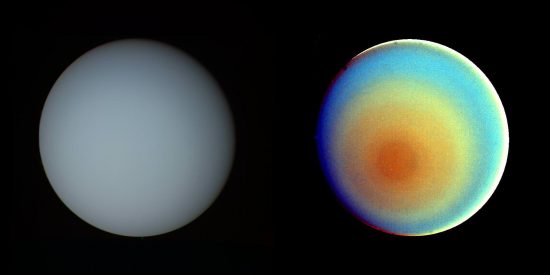
Two pictures of Uranus: “true” color and false color. Credit: NASA/JPL/Voyager 2, January 17, 1986.
Dec 26, 2018
Lateral spin.
Uranus is 50,724 kilometers in diameter at the equator, making it the third largest object in the Solar System. A unique aspect of Uranus is that its equator is tilted almost 90 degrees. Most of the other planets are tilted no more than 24 degrees past vertical.
Uranus takes 84.3 Earth years to revolve around the Sun, so it has not been extensively investigated. The Keck telescope in Hawaii came on-line November 24, 1990 and its first use of adaptive optics was on October 2003. Before that, detailed observations from Earth were impossible because of atmospheric distortion.
According to a recent press release, Uranus was hit by something about twice the size of Earth. It was that impact that is thought to cause the planet to roll onto its side. The researchers conducted computer simulations in attempt to understand how such an event could have affected Uranus. Their conclusions are based almost entirely on mechanical action.
The Hubble Space Telescope did not begin to observe Uranus until around 1998 so, there has not been time to observe even one year’s seasonal changes on Uranus. It was the Hubble telescope that discovered aurorae on Uranus, a surprise to planetary scientists. Since the magnetic field on Uranus is inclined by 59 degrees from its spin axis, aurorae are not near the planet’s poles.
Uranus is subject to gigantic storms that seem to appear from nowhere. Like the other gas giants, Uranus radiates more energy than it receives from the Sun. Saturn, for instance, radiates 2.3 times more infrared than reflection of solar radiation off its cloud tops can explain, while Uranus emits 1.1 times more radiant energy, the majority in infrared.
With an average temperature of -214 Celsius, it is difficult to account for the 585-kilometer-per-hour wind speeds on Uranus. It is most likely that the anomalous winds, the aurorae, and the faint ring system are caused by processes that Electric Universe advocates see throughout the cosmos.
For example, Saturn experiences a “mysterious dragon storm” that erupts from below the clouds. Jupiter’s Great Red Spot is hotter than its surroundings and has been spinning through its atmosphere for more than 300 years. In each case, the power needed to drive those phenomena comes from electricity.
Like Saturn and Jupiter, Uranus could be thought of as a solar system in its own right, with a family of 27 moons. It possesses a Langmuir charge sheath (plasmasphere) that isolates it from the Sun’s own charge sheath that, in turn, is isolating it from the charged interstellar medium. Its interaction with the flow of electric charge in the Solar System can explain the effects discovered by astronomers on Uranus.
Presuming Uranus to be a highly charged object in a state of dynamic equilibrium, it is possible that one or more of its moons are connected to it in the same way that Io is connected to Jupiter with powerful “flux ropes”. Those connections will strengthen as the solar wind adds greater charge density to each body. As time goes on, with more detailed and more prolonged observations, those questions ought to confirm the Electric Universe model of the Solar System.
Stephen Smith












